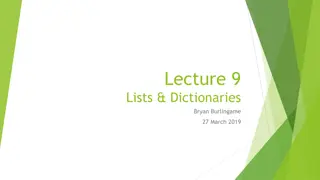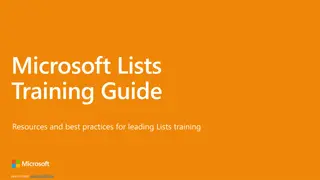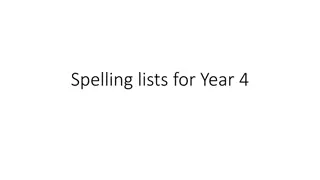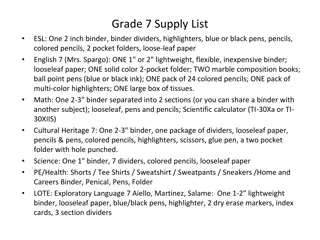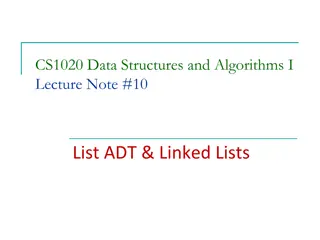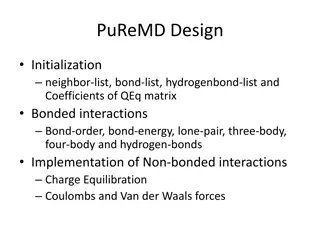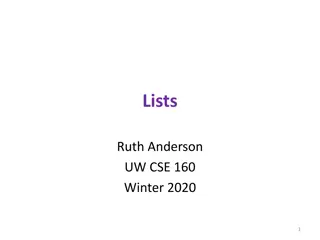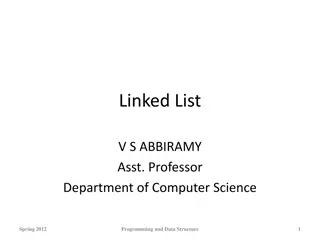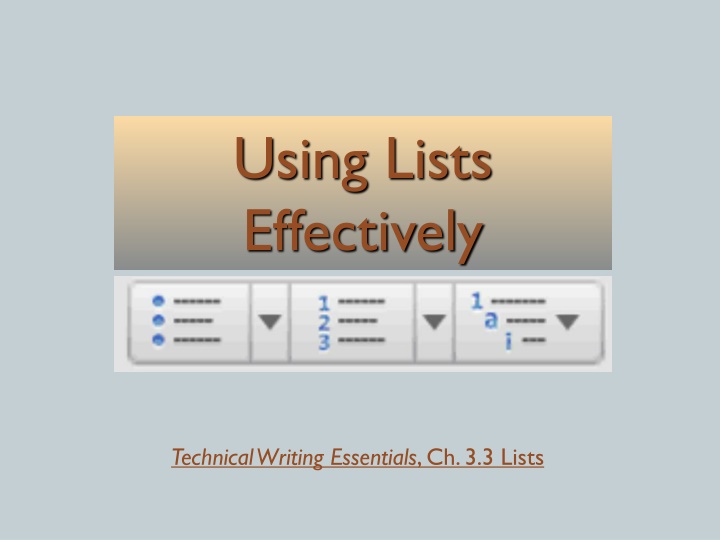
Effective Use of Lists in Technical Writing Essentials
Enhance your technical writing skills by understanding the different types of lists - bulleted, numbered, in-sentence, labelled, and nested. Discover the benefits of using lists for emphasis, readability, simplification, and creating white space in your documents. Learn when to use bullet lists, numbered lists, in-sentence lists, labelled lists, and nested lists effectively, with practical examples and guidelines to optimize your writing.
Download Presentation

Please find below an Image/Link to download the presentation.
The content on the website is provided AS IS for your information and personal use only. It may not be sold, licensed, or shared on other websites without obtaining consent from the author. If you encounter any issues during the download, it is possible that the publisher has removed the file from their server.
You are allowed to download the files provided on this website for personal or commercial use, subject to the condition that they are used lawfully. All files are the property of their respective owners.
The content on the website is provided AS IS for your information and personal use only. It may not be sold, licensed, or shared on other websites without obtaining consent from the author.
E N D
Presentation Transcript
Using Lists Effectively Technical Writing Essentials, Ch. 3.3 Lists
HERE IS A LIST OF 5 TYPES OF LISTS WE WILL REVIEW: Bulleted Numbered In-sentence Labeled Nested
WHAT ARE LISTS GOOD FOR? Emphasis: This is the primary goal of a list Readability: A list makes the text more readable, especially for instructions or steps Simplification: Lists allow you to simplify long sentences and/or paragraphs White space: Lists increase the white space on a page. Consider the structure of the above list, and its purpose.
USE BULLET LIST To emphasize two or more items When the order of the listed items in not important To increase readability and create white space in your document. Avoid creating bulleted lists of over 8 items, as this works against the idea of emphasis (and because NASA!)
NUMBERED LIST A numbered list can be used 1. For items that are most effective if placed in a particular order 2. To indicate a sequence of steps or instructions that must be completed in a certain order. Break up lists longer than 8 items (Did this list need to be numbered?)
IN-SENTENCE LIST Use in-sentence lists when (a) you prefer to keep paragraph style, and (b) the list is short. Use lower case letters or numbers enclosed in parenthesis to begin each list item. Avoid putting more than 3-4 items in this kind of list, as your sentence may become too long and confusing.
LABELLED LIST Labelled lists start with a word or short phrase (the label) that is followed by a colon; further information about the labelled item follows the colon. Here is more information about labelled lists: Complex list items: When your list items require explanation, definition, or further clarification. Label formatting: The label part if the list item should be in bold and/or italics to set it apart from the explanatory part of the list item. label
NESTED LIST Every home should contain the following kinds of containers for both hot and cold drinks: Hot beverage containers o Coffee cups/mugs o Tea cups o Thermos mugs Cold beverage containers o Water glasses o Wine glasses o Beer glasses o Cocktail glasses.
LIST LEAD-INS A list must be introduced by a lead-in sentence that adheres to the following rules: Lists must be introduced by a sentence or partial sentence that contains a subject and verb (full sentence is preferred, using the phrase the following ); the lead-in tells the reader what this is a list of. If the list lead-in sentence is a complete thought, end it with a colon to introduce the list (like this one does). If the list lead-in is an incomplete thought, do not use end punctuation, and make sure each list item completes the sentence correctly. The list lead-in and each listed item must form a grammatically-correct syntactical unit.
CONSTRUCTING LISTS Think of a list like a table: the table top is the lead-in that introduces the list, and the legs are the listed items. They have to work together. List lead-in sentence Listed items: must be parallel to avoid balance problems
EXAMPLE LIST LEAD-IN Complete Sentence Example The term design project must allow students to incorporate the following elements: Mechanical engineering principles Electrical engineering knowledge Software/programming basics.
EXAMPLE LIST LEAD-IN Partial Sentence Lead-in Example The term design project must allow students to gain experience with Mechanical engineering principles Electrical engineering knowledge Software/programming basics. NOTE: Don t use a heading to introduce a list in a formal report (but it s okay in a PowerPoint slide...). You must have a lead-in sentence to provide context for your list (what is this a list of?)
GUIDELINES FOR LISTS Adjust spacing before, after, and within list to enhance readability Don t overuse lists (or your paper will look like an outline rather than a fully written report) Avoid lists with too many items (generally avoid more than 8), or too few items (2 minimum) The first word of each list should be capitalized (or not; just be consistent).
MORE GUIDELINES FOR LISTS Make phrasing of list items grammatically parallel Use the lead-in to eliminate repetition, but check the grammatical connection between the lead in and all list items Avoid lead articles (a, an, the) on list items to reduce verbal clutter Correctly align list items and nested list items (use list paragraphing tools in Word).
USING COLONS TO INTRODUCE LISTS Generally, don t use a colon to introduce a list unless the introduction to the list is a complete thought, that is, an independent clause. Pandas have the following traits: Black and white fur Vegetarian diet Poor anger management skills.
USING COLONS IN LISTS If the lead-in is not an independent clause (i.e. not a complete sentence), you do not need to use a colon. Pandas are: Black and white Vegetarian Violent. Pandas are black and white vegetarian violent. Pandas are black and white, eat a vegetarian diet, and are prone to violence.
RECAP QUIZ 1. When should you use a numbered list? 2. What is the maximum number of items you should use in a list? 3. How do you indicate items in an in-text list? 4. When should you use a labeled list? 5. True or false: you should not use a heading as a lead in for a list. 6. True or false: You should always use punctuation after every item on a list. 7. True or false: you should always introduce a list with a phrase that ends in a colon.
WHAT KIND OF LIST IS THIS? Our design project tests our knowledge of the following principles: Mechanical engineering Forces Torque Gear trains Electrical engineering Sensors Circuits Schematics.
WHAT KIND OF LIST IS THIS? The Seven Cs refers to seven characteristics of effective professional writing. This writing should be Clear Concise Concrete Coherent Correct Complete Courteous.
WHAT KIND OF LIST IS THIS? The assessment plan for this course includes three main writing tasks: Memo: an internal proposal written in memo format Proposal: an internal proposal written in short report format Formal Report: an external Comparative Recommendation Report, written in long report format.
WHAT KIND OF LIST IS THIS? Revision of your document should be undertaken in 4 stages: 1. 2. Check formatting for readability Review content to ensure the document contains all necessary information in a logical order Check paragraphs to ensure they have strong topic sentences and unified content 3. 4. Edit sentence style and structure to make sure it is formal, clear, and correct Proofread for grammar, punctuation, spelling, and format errors. 5.
WHAT IS WRONG WITH THIS LIST? Six Kinds of Lists: 1. Bullet lists 2. Numbered lists 3. Lists can be written in sentence form with letters introducing them 4. Labeled lists 5. nested Also called a list-within-a-list .






